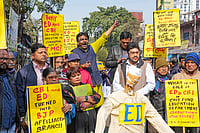Whichever way you look at it, the fact remains that this was one of the boldest railway budgets ever. Rather than focusing only on social obligations and political necessities, the budget looked at market logic and commercial considerations. Agrees a Delhi-based economist, "This was more like a corporate statement. We had underestimated the minister’s prowess in producing something like this. The budget looks at pressing issues through the eyes of a company’s CEO, rather than from the perspective of a minister who’s trying to balance political and social priorities. We’re probably looking at a new era for Indian Railways."
Laloo’s earnestness can be gauged by his budget speech, which used phrases that could have been part of any corporate annual report. He talked of reducing unit costs, encouraging transfer of technology from MNCs, giving top priority to reduce wagon turnaround time, adopting the ‘increase volume, reduce unit cost’ strategy to boost profits and improve load factors. Even the body language was different and the minister started his speech by saying, "... I rise to present the budget estimates 2006-07 for the Indian Railways at a point in time when there has been a historic turnaround in the financial situation of Indian Railways."
It’s true that the railways has performed well in the past few years. Compared to the previous year (2004-05), operating revenues are up by 15 per cent, gross traffic receipts by 16 per cent, and freight and passenger revenues by 18 per cent and 11 per cent, respectively. Its internal generation will zoom from a mere Rs 350 crore in 2000-01 to a "historic" high of Rs 11,000 crore in 2005-06. While the frenetic growth of the Indian economy has played its role, there’s been an improvement in efficiency too. Still, experts feel that Indian Railways didn’t stand a chance to compete with other modes of transport. That’s where Laloo stepped in and slashed AC-I and AC-II fares to make them as attractive as low-budget airlines’ offers. To further woo passengers, he has promised to improve services—both in trains and on platforms. In the near future, some stations will have atms, cybercafes and food plazas. Wait-listed travellers will have the option of getting upgraded to higher classes—and thereby more chances of getting a berth—without having to pay an additional penny. Laloo confidently espoused that "if we can’t catch them (low-budget airlines) in speed, we’ll match them in costs and services."
But what’s innovative is the introduction of flexible pricing for both passengers and freight. "Railway passenger fares and freight rates remain unvarying for all seasons and routes, whereas tariffs in airlines and road sectors vary depending upon the demand and the season. In order to be able to effectively face the challenges posed by stiff competition...I propose to introduce a Dynamic Pricing Policy for freight as well as passengers...," he said. In case of freight, he talked about discounted rates for all customers during non-peak season, wagons headed in empty flow directions, loyal customers and long-term contracts.
In a bid to increase freight margins, the railways has started loading an additional 4-8 tonnes in wagons this year. According to Laloo, "With the increase of just one tonne in the loading capacity of a wagon, our annual loading capacity goes up by about one crore tonnes. In the last two years, we have increased the loading capacity of key wagons by four tonnes per wagon and enhanced the railways’ annual loading capacity by four crore tonnes." To achieve the same objective in passenger trains (subsidised by freight), the railways has sought to reduce travel time per train and increase coaches in others to improve occupancy.
Apart from these, Laloo also sketched a long-term strategy to make the railways more profitable. This includes the construction of a dedicated freight corridor, introduction of new, high-load freight wagons that can ferry 80 tonnes (against 64 tonnes now), privatisation of container trains to boost public-private partnerships and seeking foreign technology for wagon construction. The fact is that the railways is incurring huge losses in passenger services and has to generate more profits through freight.
But this is an area where critics disagree with Laloo. Explains N. Venkatesan, a former member of the Railway Board, "He has missed the chance to raise second-class and suburban fares. This is where the railways is incurring heavy losses. The suburban trains in Mumbai and Calcutta require huge investments and, therefore, one has to be realistic in pricing. There’s no point in saying one’s running a commercial establishment and then running annually to the exchequer for budgetary support."
Others contend that the ministry has gone back on its focus to improve safety. "Last year, the focus was on safety and the minister announced grand plans. This year, it was dismissed in one para (actually 12 lines). Given the number of rail accidents every year, this should be a priority," says a Delhi-based expert. However, the ministry counters that the number of rail accidents has come down from 473 in 2001 to 234 now. What baffles most observers is that Laloo is trying to balance himself on two boats. On the one hand, he thinks of himself as a CEO trying to pen a survival strategy for the railways. But, on the other, he behaves like any other politician. That is clear from the announcement of 55 new trains, even as the minister claims he’s trying to increase coaches on existing trains. Similarly, the initiative to introduce AC Garib Raths doesn’t make sense. In fact, the Left parties have said that the Garib Rath is meant to increase fares as they will be higher-priced than ordinary trains. Finally, what’s the point of a CEO, whose home state’s capital, Patna, is the most mentioned city in the entire speech?
"The butter is being spread thinly. Yet again, we have a basket of new projects. But what has happened to the ones that were announced in the previous budgets? Shouldn’t there be an action-taken report so that people know what’s happened to the investments announced in the previous years?" asks a Delhi-based analyst. Laloo, it seems, is not bothered about such nitty-gritties. The joke in Rail Bhavan is that the minister looks at three questions while finalising the annual budget: will it affect the passengers, will it lead to more profits for the railways, and will it prove to be politically embarrassing for me?






















